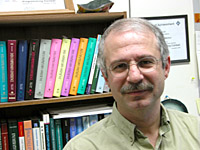|
|
In his 2004 paper published in The Computer Journal, Dr. Ziya Arnavut (computer science) demonstrated that a technique he developed to help compress digital files, which he calls "Inversion Coder," yields superior compression results when used in the second step of a compression algorithm.
Recently, Prof. Hidetoshi Yokoo of Gunma University in Japan published an article in the prestigious international journal, IEEE Transactions on Information Theory, which theoretically proved Dr. Arnavut’s thesis.
A letter from Professor Yokoo to Dr. Arnavut states, “I have recently shown in my own framework that your inversion coder is relatively superior to other similar coders.”
Making all the difference in the end: "lossless" versus "lossy"
Data compression is the process of converting music, photographic, video, and data files, which tend to be large, into smaller, more manageable units, so they can be exchanged quickly over the internet with no loss in quality. In the field, developers describe a conversion that retains all the quality of the original file is a "lossless" one. A conversion that results in lower quality is called "lossy."
|
Get a test copy of the "Burrows-Wheeler with Inversion Coder" on Dr. Arnavut's website. |
As Dr. Arnavut explained, “The goal of data compression is to represent an information source (for example, a data file, a speech signal, an image, or a video signal) as accurately as possible using the fewest number of bits. In our daily life most often we use a compressor, such as WinZip, bzip2, and JPEG, to compress text or image files. Losslessly compressed files are often three or four times smaller than the original file. If the compression scheme is lossless, we can obtain the original. This saves us time in transmission since we send a smaller file. Of course, disk space too. The technique that I developed, Inversion Coder, is a lossless technique and yields superior results compared to previous techniques.”
His most recently-published article, “Lossless compression of color palette images with one-dimensional techniques,” (co-authored with Ferat Sahin of the department of electrical engineering at Rochester Institute of Technology) appears in Journal of Electronic Imaging (Vol. 15, No. 2).




